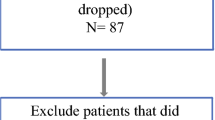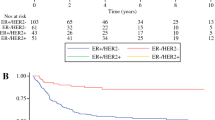Abstract
Background: Inflammatory breast cancer is a locally advanced tumor with an aggressive local and systemic course. Treatment of this disease has been evolving over the last several decades. The aim of this study was to assess whether current therapies, both surgical and chemotherapeutic, are providing better local control (LC) and overall survival (OS). We also attempted to identify clinical and pathologic factors that may be associated with improved OS, disease-free survival (DFS), and LC.
Methods: A 25-year retrospective review performed at the City of Hope National Medical Center identified 90 patients with the diagnosis of inflammatory breast cancer.
Results: Of the 90 patients identified with inflammatory breast cancer, 33 received neoadjuvant therapy (NEO) consisting of chemotherapy followed by surgery with radiation (n = 26) and without radiation (n = 7). Fifty-seven patients received other therapies (nonNEO). Treatments received by the nonNEO group consisted of chemotherapy, radiation, mastectomy, adrenalectomy, and oophorectomy, alone or in combination. The median follow-up was 28.9 months for the NEO group and 17.6 months for the nonNEO group. Borderline significant differences in the OS distributions between the two groups were found (P =.10), with 3- and 5-year OS for the NEO group of 40.0% and 29.9% and for the nonNEO group of 24.7% and 16.5%, respectively. DFS and LC were comparable in the two groups. Lower stage was associated with an improved OS (P < .05). The 5-year OS for stage IIIB was 30.9%, compared to 7.8% for stage IV. In those patients with stage III disease who were treated with mastectomy and rendered free of disease, margin status was identified by univariate analysis to be a prognostic indicator for OS (P < .05). The 3-year OS, DFS, and LC for patients with negative margins were 47.4%, 37.5%, and 60.3%, respectively, compared to 0%, 16.7%, and 31.3% in patients with positive margins.
Conclusions: This study suggests that in patients with inflammatory breast cancer and nonmetastatic disease, an aggressive surgical approach may be justified with the goal of a negative surgical margin. Achievement of this local control is associated with a better overall outcome for this subset of patients. The ability to obtain negative margins may further identify a group of patients with a less aggressive tumor biology that may be more responsive to other modalities of therapy.
Similar content being viewed by others
REFERENCES
Osteen RT, Cady B, Chmiel JS, et al. 1991 National survey of carcinoma of the breast by the Commission on Cancer. J Am Coll Surg 1994;178:213–221.
Bell C. A System of Operative Surgery. vol 2. Hartford: Hale and Hosmer, 1814:136.
Haagensen CD, Stout AP. Carcinoma of the breast. II. Criteria of operability. Ann Surg 1943;118:859–870.
Rogers CS, Fitts WT. Inflammatory carcinoma of the breast: a critique of therapy. Surgery 1956;39:367–370.
Fields JN, Kuske RR, Perez CA, et al. Prognostic factors in inflammatory breast Cancer: univariate and multivariate analysis. Cancer 1989;63:1225–1232.
Fields JN, Perez CA, Kruske RR, Fineberg BB, Bartlett N. Inflammatory carcinoma of the breast: treatment results on 107 patients. Int J Radiat Oncol Biol Phys 1989;17:249–255.
Chu AM, Wood WC, Doucette JA. Inflammatory breast Cancer treated by radical radiotherapy. Cancer 1980;45:2730–2737.
Perez CA, Fields JN, Fracasso PM, et al. Management of locally advanced carcinoma of the breast. II. Inflammatory carcinoma. Cancer 1994;74:466–476.
Zucali R, Uslenghi C, Kenda R, et al. Natural history and survival of inoperable breast Cancer treated with radiotherapy and radiotherapy followed by radical mastectomy. Cancer 1976;37:1422–1431.
Hortobagyi GN, Buzdar AU. Progress in inflammatory breast cancer: cause for cautious optimism. J Clin Oncol 1986;4:1727–1729.
Rouesse J, Friedman S, Sarrazin D, et al. Primary chemotherapy in the treatment of inflammatory breast carcinoma: a study of 230 cases from the Institut Gustave-Roussy. J Clin Oncol 1986;4:1765–1771.
Haagensen CD. Inflammatory carcinoma. In: Diseases of the Breast, 3rd edn. Philadelphia: WB Saunders, 1986:808–814.
Ellis DL, Teitelbaum SL. Inflammatory carcinoma of the breast: a pathologic definition. Cancer 1974;33:1045–1047.
Saltzstein SL. Clinically occult inflammatory Cancer of the breast. Cancer 1974;34:382–388.
Beahrs OH, Henson DE, Hutter RVP, Kennedy B (eds). Handbook for the Staging of Cancer. Philadelphia: JB Lippincott, 1993: 163–165.
Cox DR. Regression models and life tables. J R Stat Soc B 1972;34:187–202.
Kaplan EL, Meier P. Nonparametric estimation from incomplete observations. J Am Stat Association 1957;53:457–481.
SAS Institute Inc. SAS Technical Report P-217, SAS/STAT Software: The PHREG Procedure Version 6. Cary, NC: SAS Institute Inc., 1991.
Kokal WA, Hill LR, Porudominsky D, Beaty JD, Kemeny MM, Riihimaki DU, Terz JJ. Inflammatory breast carcinoma: a distinct entity. J Surg Oncol 1985;30:152–155.
Jaiyesimi IA, Buzdar AU, Hortobagyi G. Inflammatory breast cancer: a review. J Clin Oncol 1994;10:1014–1024.
Contesso G, May-Levin F, Delarue JC, et al. Inflammatory tumors of the human breast: determination of estrogen and progesterone receptors. Recent Results Cancer Res 1984;91:157–168.
De Larue JC, May-Levin F, Mouriesse H, et al. Oestrogen and progesterone cytosolic receptors in clinically inflammatory tumors of the human breast. Br J Cancer 1981;44:911–916.
McCready DR, Hortobagyi GN, Shu W, et al. The prognostic significance of lymph node metastasis after preoperative chemotherapy for locally advanced breast cancer. Arch Surg 1989;124:21–25.
Singletary SE, Ames FC, Buzdar AU. Management of inflammatory breast cancer. World J Surg 1994;18:87–92.
Antman K, Bearman S, Davidson N, et al. Dose intensive therapy in breast cancer: current status. In: Gale RP, Champlin RE, eds. New Strategies in Bone Marrow Transplantation. New York: Alan R. Liss, 1990:423–426.
Author information
Authors and Affiliations
Rights and permissions
About this article
Cite this article
Curcio, L.D., Rupp, E., Williams, W.L. et al. Beyond Palliative Mastectomy in Inflammatory Breast Cancer—A Reassessment of Margin Status. Ann Surg Oncol 6, 249–254 (1999). https://doi.org/10.1007/s10434-999-0249-3
Received:
Accepted:
Issue Date:
DOI: https://doi.org/10.1007/s10434-999-0249-3




